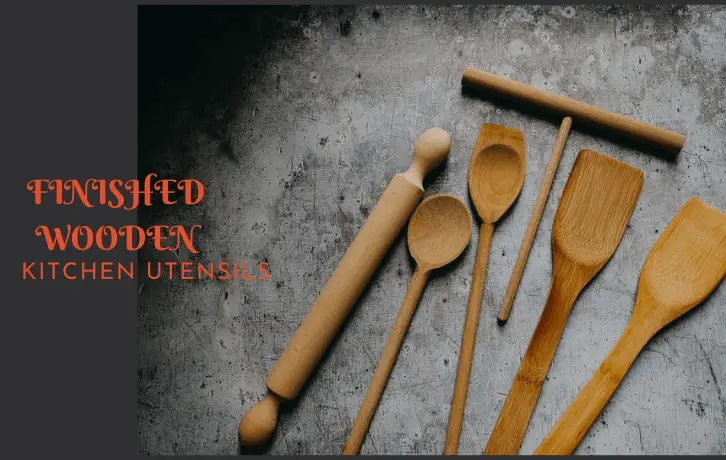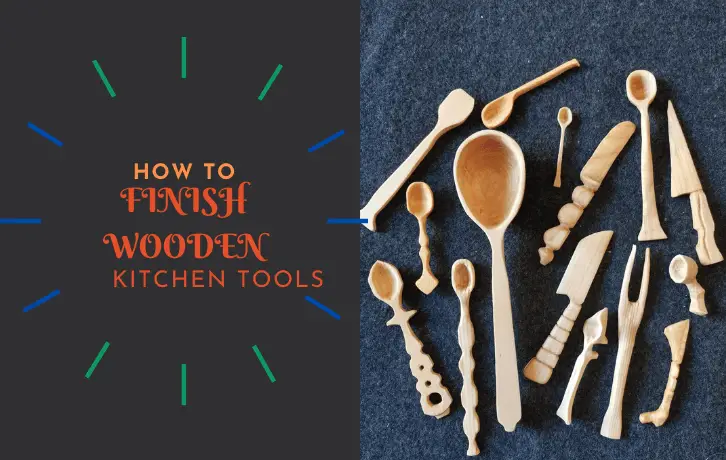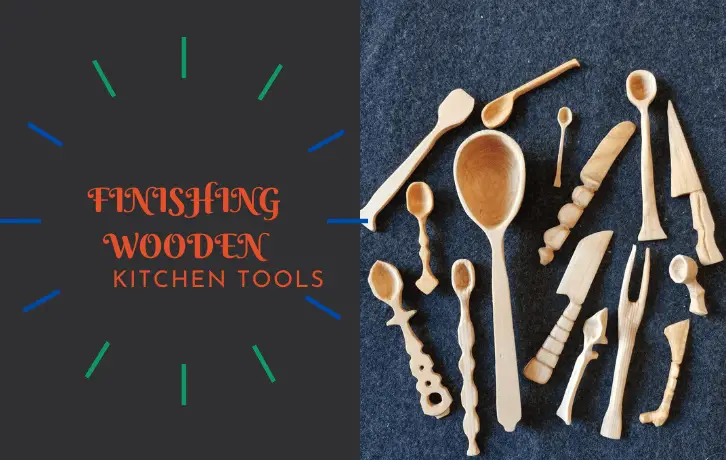Finishing your wooden kitchen utensils is one step in ensuring that your items last for an extended period and are easy to use. There are different ways used to finish wood objects, just as shown in the article
For an extended period, wood has been one of the world’s most loved and used materials. Wooden utensils always create a fantastic magical look and a beautiful warm atmosphere that help us transform mere groceries into incredibly delicious and healthy food, compared to those cooked with modern plastic utensils containing harmful toxins.
Although wooden kitchen utensils are the most recommended tools to use in our kitchen, it is always important to give them a food-safe finish regularly. There are many reasons why you should finish your wood items, and they include:
Advantages of finishing wooden kitchen utensils

They become durable.
The advantage of choosing wooden kitchen items is that, if properly cared for, they can endure for a long time. If given a good finish, they become difficult to break and make it simple to stir even the thickest contents at the bottom of your pot.
Enhances its beauty.
Who doesn’t like being surrounded by lovely things? Of course, nobody. When you finish your wooden kitchen items, you allow the magical beauty to shine, and it also makes your kitchen look unique and different at all times. The best way to maintain that incredible view in your kitchen is to prioritize food-safe wood finishing.
It protects the wood from everyday use.
Nothing looks brand new every day, and wooden kitchen utensils are no exception. After being used for a while, the wood surface gets a slightly rough feeling. It is necessary to protect the items from everyday environmental damage, and you can do that by providing them with a good finish.
It helps the surface be more resistant.
When you keep your kitchen wood items saturated with food-safe finishes, it helps control the reduction of moisture content in your wood, increasing the wooden utensil’s ability to resist splitting and cracking.
Reduces Seasonal Movement
Finishing your wood items frequently helps reduce the tendency of wood to absorb and release moisture, and it also helps minimize environmental problems that damage joinery. Treat all surfaces equally to avoid any cupping of boards when completing your kitchen wood products.
It is easy to clean.
Cleaning wooden kitchen items only take a few minutes, resulting from their softness and gentleness. But it is always advisable to clean them right after use to prevent them from accumulating lots of oil and dust that may lead to cracking or splitting.
Now let’s look at ways of finishing your wooden kitchen items.
Read Next
- Cool Crafts – How to Burn Designs on Wooden Spoons
- Best Finish for Wood Carving
- Can You Stain Over Polyurethane? Glazing Poly Explained
- How to Paint Basswood: A Beginner’s Guide
- Spoon Carving Kit for Beginners
- What Knives Do I Need to Carve a Spoon
What Is The Best Way to Finish Wooden Kitchen Utensils?
1. Use of oil
There are many types of wood finishes, but some are not suitable for kitchen items. In many cases, people prefer using oil finishes as they penetrate deep into the surface of the wood, helping it resist absorption. Apart from that, oil finishes are easy to apply, easy to maintain, and non-toxic. Shown below are different types of oil finishes.
The different types of oil finishes that are used on wood utensils.
The oil has been used for edges by woodworkers and metal crafters to create the perfect finish. It is also called China wood oil. Though it is used in various fields, it is recommended as one of the safest finishes for your wooden utensils due to its durability and ability to resist water. It is, however, difficult to apply and requires multiple coats.
ii). Food Grade Mineral oil
Mineral oil, such as pure tung oil, has been used for a long time. It is ideal for use in kitchen utensils because it is colourless, odourless, tasteless, and completely inert. It’s non-toxic and works best on water-based stains. You should use mineral oil regularly to keep your wood surface looking lovely and natural. It is also suitable for sealing the wood without leaving a film finish.
iii). Linseed Oil
They are seeds made from flax seeds; though linseeds are popularly known for nutrition, they also protect the interior and exterior wood surfaces. The seeds are non-toxic, environmentally friendly, and resistant to water.
iv). Walnut oil Finish
It is a slow-drying oil made from linoleic acid and works best in a warm environment and at room temperature. Unlike many finishes, walnut oil does not form a layer on the wood surface, thus preventing your finish from chipping off.
First, walnut oil is heated to break down proteins that cause allergic reactions, thus making the oil safe and easy to use. To obtain a nice finish, you should apply several coats of oil to your wood surface.
Olive oil wood finishes
Many people always think that olive oil causes damage to wood products, but what they’re missing out on is that for ages now, olive oil has been used to feed the wood and help bring out its stunning natural look.
It is even more preferable because it does not require any unique application technique, and it is easier to hold and costs little.
Vegetable oil
While not all vegetable oils are suitable for finishing, you can use some to treat and varnish wood. Vegetable oils quickly absorb into the wood, and depending on the number of layers applied; they leave a sophisticated finish on the wood surface over time.
vii). Coconut oil
The most recommended type of coconut oil for food-safe finishing is fractionated coconut oil. This type of oil has been refined to remove long-chain triglycerides, hence providing a safe, non-toxic finish to your kitchen wooden items.
How to apply an oil finish
- Start by flooding the surface of your wood.
- Using a clean rag, wipe the oil over the entire surface.
- Leave the oil to soak into the wood for a short period.
- If the wood surface has stubborn grains or rough spots, use wet sand to smooth them.
- Rub the surface with polymerizing oil for 20 minutes and leave it overnight.
- Repeat the process three to four times until you get the desired look.
2. Using wax
Wax is blended with oil to form a non-drying substance capable of covering and resisting. It is one of the most popular food-safe finishing options. Included are three types of wax used for wooden kitchen utensils, and they include
i). Food Grade Beeswax
It is a natural and non-toxic type of wax that enables you to have the most beautiful wood products in your home. Besides, beeswax is affordable, resistant to harsh environmental conditions, and suitable for your wooden chop boards, spoons, and bowls.
ii). Palm wax
Also known as Brazil or carnauba wax, though used in other industries, it is also used to finish wooden kitchen items due to its ability to produce a glossy finish and protect the underneath grain, keeping it natural and attractive.
iii). Paraffin wax
Petroleum is used to make paraffin wax, just like mineral oil. It’s a good choice for finishing because it’s food-safe and requires less time to cure. It’s frequently used to keep cheeses and jams fresh.
How to apply a wax finish to your wooden kitchen utensils
- Dip a clean piece of cloth in warm water.
- Clean your wood surface using that fabric to remove dust, grease, and oil.
- Using 120 grit sandpaper sand down your wood to lightly roughen the surface.
- Using a clean, lint-free piece of cloth, apply the wax in a circular motion, rubbing every part of your wood surface.
- Leave the polish to dry.
- When dry, use a clean cloth to wipe away the excess.
- Use a baffling material to turn the wax into a natural sheen.
3. Using Shellac
Shellac has the same characteristics as most oils, making it food-safe and environmentally friendly. It is a pure and non-toxic substance that is quick-drying and easy to use. Though suitable and recommended by many woodworkers, it is not resistant to water and heat; it needs regular maintenance.
How to Apply Shellac Finishes to Your Carved Wood Utensils
- Clean the surface thoroughly using a clean piece of cloth.
- Using another neat piece of fabric, apply Shellac smoothly along the grain of the wood.
- Let the wood dry for some time.
- When the wood is dry, lightly sand the wood using an open coat of sandpaper.
- Repeat the process several times to get the desired look
Though I have recommended all of the above food-safe finishes for wooden kitchen utensils, it is always good to think about a few things before deciding on a finish for your wood items.
Factors to consider when choosing finishes for your wooden kitchen utensils
The colour of the finish
Although some people prefer colourful finishes, some may like to retain the natural beauty of their wood. Choosing the colour of your wood finish helps protect its surface and enhance its grain.
1. Durability
Most wooden kitchen items require a finish that will enhance their appearance, give them a natural look, and help them last a long time. Oil finishes are always the best at providing all those qualities.
2. Time for application and drying
When choosing your wood finish, make sure that you are familiar with the requirements of the product. This will help you know how to apply it and how long it takes to dry. Different finishes are applied differently, and they also dry at different rates. Some may be sprayed, while others require the use of a cloth.
3. The type of wood
The type of wood is also a factor to consider when choosing a finish. In most cases, softwood has an open grain compared to hardwood, so it can quickly soak up the finish before the required time, ruining the project.
4. Odour
It’s best to apply a wood finish in a well-ventilated environment, as some finishes have a strong unpleasant odour that can cause respiratory difficulties and dizziness.
Products to use with caution as your food safety finishes
1. Lacquer
They are types of finishes that take a long time to penetrate the wood grain and do not cure quickly. If you’re going to use lacquer to finish your wooden kitchen objects, be sure it’s food-safe and that you only use it on items that won’t be roughed up.
2. Polyurethane
Polyurethane was once considered food-safe, and our grandparents used it to prevent their wooden kitchenware from chipping. But today, the finish is no longer food safe as metallic driers are added to it to help reduce the required time for a complete cure.
The metallic driers pose a health risk to our bodies and should be allowed to cure completely to provide a food-safe coating.
3. Vegetable oil
Some vegetable-based oils are considered safe for your food, but most of them should be used with proper instructions or avoided altogether. Most vegetable oils thicken on utensils, generating an off feeling and discolouring them. Apart from that, they can also become rancid and make your food-safe wooden spoons smell bad.
Bottom line
Watching wooden kitchen appliances glow and have their beautiful natural look is always the dream of every passionate woodworker. Though frustrating, it is always advisable to finish your wooden objects to increase their lifespan, make them easy to use, and consider some factors just as shown above.
If you do not know where to start with your wood finishing process, this article will guide you through the different types of food-safe finishes and how to apply them.

